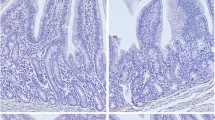Summary
The influence of the bile acid binding, non-absorbable substance cholestyramine on alimentary production of gallstones in young hamsters was examined by rearing one group of the animals on a diet without added fat containing 74.3% glucose as the carbohydrate component (and twice the usual amount of vitamins A, D3 and E), and another group on the same diet supplement with 3% cholestyramine at the expense of glucose. The animals were killed and autopsied after having received the experimental diets for 42–43 days from the age of 30–32 days.
The cholestyramine supplement markedly reduced the production of cholesterol gallstones, but not to the same degree as that obtained in numerous previous experiments by replacing the content of glucose in the basal diet by rice starch.
Further, the cholestyramine supplement markedly favored production of amorphous pigmented gallstones, an effect not encountered when cholesterol gallstones are eliminated by replacing the content of glucose in the basal diet by rice starch.
The growth of the animals was not significantly retarded by the cholestyramine supplement, and none of the animals showed gross signs of deficiency of fat-soluble vitamins.
The amount of vitamin A in the livers was of the order of magnitude of 100 microgram per gram in both groups, but significantly lower in the group receiving cholestyramine than in the group receiving the unsupplemented diet.
Zusammenfassung
Der Einfluß der gallensäure-bindenden, nicht resorbierbaren Substanz, Cholestyramin, auf die alimentäre Entwicklung von Gallensteinen in jungen Hamstern wurde untersucht.
Eine Gruppe von Hamstern wurde mit einer Cholesterin-Gallensteine hervorrufenden, 74,3% Glucose enthaltenden Nahrung ohne Fettzulage gefüttert. Eine zweite Gruppe erhielt dieselbe Nahrung mit Zusatz von 3% Cholestyramin an Stelle von 3% Glucose. Das Alter der Tiere beim Versuchsbeginn war 30–32 Tage. Die Fütterung dauerte 42–43 Tage.
Der Cholestyramin-Zusatz bewirkte eine beträchtliche Minderung der Bildung von Cholesterin-Gallensteinen. Die Schutzwirkung diesem Gallenstein-Typus gegenüber war aber geringer als diejenige, welche man durch Ersatz der Glucose durch Reisstärke erreichen kann.
Der Cholestyramin-Zusatz begünstigte die Bildung von amorphen, pigmentierten Gallensteinen beträchtlich, eine Komplikation, welche bei der Elimination der Cholesteringallenstein-Bildung durch Ersatz der Glucose durch Reisstärke nicht auftritt.
Die Gewichtszunahme der Tiere wurde durch den Cholestyramin-Zusatz nicht signifikant gehemmt, und Symptome eines Mangels an fettlöslichen Vitaminen wurden nicht beobachtet. (Um eine Hemmung der Resorption der fettlöslichen Vitamine durch die Bindung von Gallensäuren an Cholestyramin entgegenzuwirken, war die Nahrung beider Gruppen von Tieren mit der doppelten der gewöhnlich benutzten Menge der Vitamine A, D3 und E versehen). Unter diesen Umständen war der mittlere Gehalt der Leber an Vitamin A von der Größenordnung 100 Mikrogramm per g in beiden Gruppen, aber signifikant geringer in der mit Cholestyramin-Zusatz als in der ohne Cholestyramin-Zusatz gefütterten Gruppe.
Similar content being viewed by others
References
Dam, H. andF. Christensen, Z. Ernährungswiss.2, 154 (1962).
Schoenfield, L. J. andJ. Sjövall, Amer. J. Physiol.211, 1069 (1966).
Bergman, F. andW. van der Linden, Gastroenterology53, 418 (1967).
Dam, H. andF. Christensen, Z. Ernährungswiss.2, 36 (1961).
Ames, S. R., H. A. Risley andP. L. Harris, Anal. Chemistry26, 1378 (1954).
Dam, H. andF. Christensen, Z. Ernährungswiss.2, 91 (1961).
Prange, I., F. Christensen andH. Dam, Z. Ernährungswiss.3, 59 (1962).
Dam, H., I.Prange and E.Søndergaard, Z. Ernährungswiss. (In press 1969).
Eriksson, S., Proc. Soc. Exp. Biol. Med.94, 578 (1957).
Prange, I., F. Christensen andH. Dam, Z. Ernährungswiss.7, 59 (1966).
Dam, H., I. Prange andF. Christensen, Z. Ernährungswiss.6, 97 (1965).
Author information
Authors and Affiliations
Rights and permissions
About this article
Cite this article
Søndergaard, E., Prange, I. & Dam, H. Alimentary production of gallstones in hamsters. Z Ernährungswiss 9, 174–179 (1969). https://doi.org/10.1007/BF02021497
Received:
Published:
Issue Date:
DOI: https://doi.org/10.1007/BF02021497




